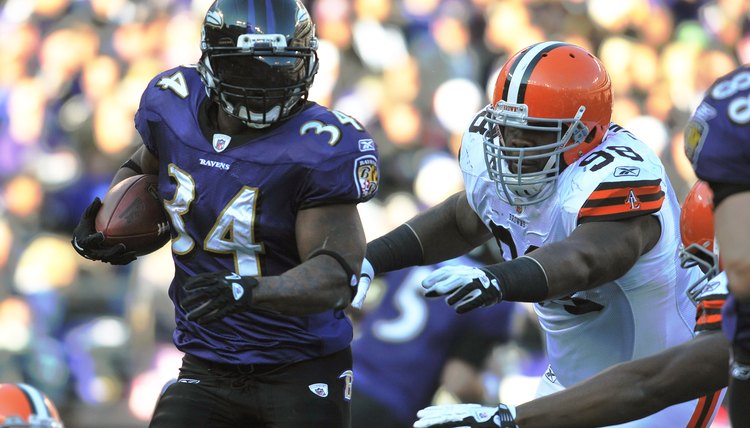Football Visor Rules

Anyone who has watched a game of American football knows that the game includes dozens of rules to be followed. All levels of organized football stipulate rules regarding the types of visors that may be attached to a player's helmet. The governing bodies regulating high school, college and professional football have visor rules that are similar in scope but slightly different in terms of enforcement and penalties.
Football Visors
Football visors have come into vogue since the start of the millennium; according to Mike Sterner, who oversees marketing for Oakley, the largest producer of football visors, purchases doubled every year between 2004 and 2006. While all football helmets must include at least a wire face mask with gaps, players who wear only a wire mask occasionally suffer eye injury when an errant finger travels through a hole in the grid. Adding a visor completely eliminates the possibility of receiving a blow to the face through the wire grid. There are other potential benefits to visors; a player who is sensitive to sunlight may wear a tinted mask to prevent migraines or another light-induced ailment, while former NFL running back Ricky Williams famously wore a tinted visor to help him cope with social anxiety disorder.
NFL Rules
The National Football League began legislating the types of helmet visors that are acceptable to wear starting with the 1998 NFL season when it outlawed tinted visors. According to Section 4 Article 3a of NFL rules, a player must provide the league with a doctor's note and must obtain approval from the league office in order to wear a tinted visor on the field of play. Clear visors are acceptable for all players without league approval. If an NFL official sees a player wearing an illegal visor, he informs the player of the violation at the next change of possession. The player must remove the illegal visor from his helmet before he is allowed to return to the field of play. If a player cited for a visor violation attempts to return to the field without removing the visor or he is observed wearing the illegally visored helmet on the sideline, he may be ejected from the game and subjected to further discipline from the league.
NFHS Rules
The National Federation of State High School Associations, or NFHS, has a slightly more restrictive rule in place than the NFL. Rules 1-6c4 specifies that high school football players are prohibited from wearing tinted visors or any other tinted eyewear. Additionally, any visor that is attached to the face mask must be constructed of a molded rigid material, which is not a required specification for NFL visors.
NCAA Rules
College football's governing body, the National College Athletic Association, specifies rules similar to the NFHS regarding visors. According to NCAA rule 1-4-5s, visors must be clear and free from tint, and they must be made of material that is molded and rigid. If a player is found using an illegal visor, his team is charged with a timeout, and the player must leave the game until the violation is fixed.
References
Writer Bio
Dan Howard is a sports and fitness aficionado who holds a master's degree in psychology. Howard's postgraduate research on the brain and learning has appeared in several academic books and peer-reviewed psychology journals.
